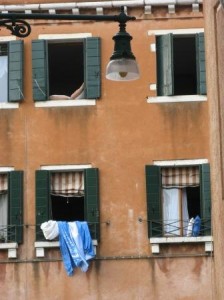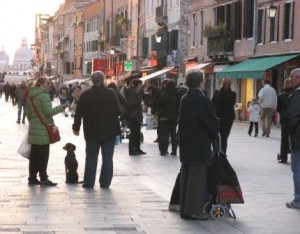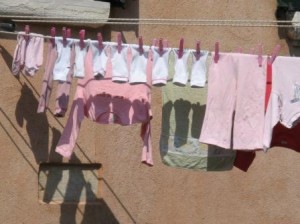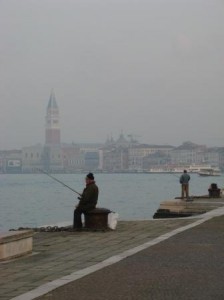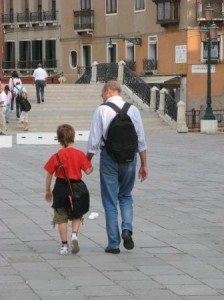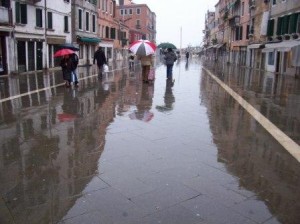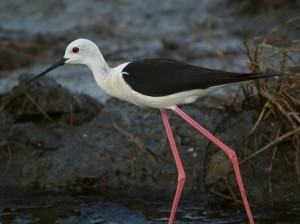
The gustatory sense is next on my list of attributes of the sensual Venice because this time of year is swamped, decks awash, in great things to eat. If one is inclined (“one” meaning “me”) to focus on seasonal comestibles, then this is a period that verges on the orgiastic. Naturally I try to conceal this. Sort of.
From October to April we eat in a sensible-shoes sort of way –plenty of local food, warm, sustaining, totally good for you but not very exciting, if you don’t count the castradina in November or the roast eel on Christmas Eve, and several forms of pastry. But this somewhat restrained diet means that by spring I’m watching for the first asparagus with an intensity most people give to watching the Powerball drawing.
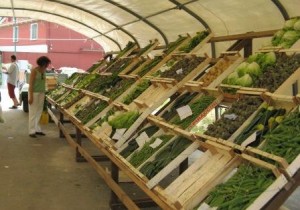
When I finally see that first green stalk, it’s like the starter’s gun on a new season of — how can I put this delicately? I can’t — glorious glut.
First comes the asparagus, which is steamed or boiled and often eaten with hard-boiled eggs cut in half. Sprinkle this assortment with salt, pepper, and extravirgin olive oil, and you’ve had dinner.
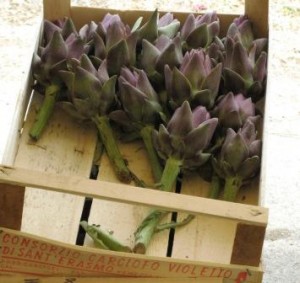
Shortly thereafter the artichokes arrive. Not just any artichoke, but the carciofo violetto from Sant’ Erasmo. This is a purple variety that thrives around the lagoon — we’ve had them from the Vignole, and from Malamocco, though apartment buildings now cover the artichoke fields that Lino remembers. The encyclopedia says they are also to be had from Chioggia, but I’ve never knowingly eaten anything from Chioggia except a type of radicchio. In any case, the saline environment evidently does something important to the old Cynara scolymus, if my taste buds are not lying to me.
This spring we rowed over to Sant’ Erasmo many times, which meant that we’ve eaten more artichokes in the past five weeks than ever before, I think. We’d come home with bags of these little creatures, often cut off the plant just for us, paying about two-thirds less than the price at the Rialto. We’d pull off the outer leaves and eat the inner morsel raw. We’d simmer them in olive oil and garlic. We’d cut them in half and throw them on the griddle. We even experimented with boiling them and then storing them in a jar full of olive oil. No verdict yet on how those turned out, but it’s hard to imagine they could be bad.

Peas: Fresh peas are next up, the crucial element to risi e bisi (REE-zee eh Bee-zee), or pea risotto, a Venetian classic. Preparing artichokes is a very grown-up sort of thing to do, but shelling peas takes me very, very far back. I could be anywhere (say, Venice) and it would still make me feel like I was sitting on somebody’s back porch. The only thing I object to about fresh peas is the same thing I object to about fresh pinto beans: you pay by weight, which means you’re paying for a whole pod in order to get a batch of little pellets. That’s another thing I’m going to have to change when I get to be in charge of the world.
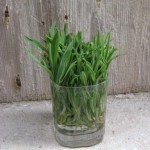
After a few weeks of glory this trinity of sublime plant life has begun to fade from the scene and I will not be eating them again till next spring, even if I could get them from hothouses in Sicily or Israel or who knows where. But other things will be along — lettuce and string beans and tomatoes and eggplant. The faithful old zucchine. Fresh tomatoes right off the vine — we make our own sauce. Around here, “Eat your vegetables” sounds like an invitation to a party.
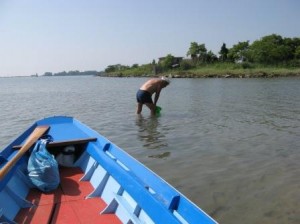
And the clamming season is now officially open — to the entire world, if your average Sunday afternoon in the lagoon is any indication. Of course it’s open all year to the professionals, but families spend recreational summer hours digging around in the shallows, and it is probably Lino’s favorite thing to do, way ahead of sleeping or eating. Maybe even drinking. It must be like meditation or yoga. He can do it for hours.
So we’ve already been out a few clam-hunting expeditions. The trick is to find some patch of terrain that hasn’t already been ravaged by legions of trippers. Lino is very patient and he actually looks for the clams, one by one, whereas most of the other mighty nimrods just claw up fistfuls of mud hoping to find something good. These are not fishermen, these are locusts.
After we’ve let the clams soak in a bucket of lagoon water for several hours, we take them home, and get ready for the Great Cooking Thereof. This may not happen immediately; we may have to leave them in the fridge in their plastic bag for a little while. They kind of hang out in there till we’re ready to cook them. When we put the bag in the sink, I can hear them making moist little shifting and tchk-tchk noises. Yes, they’re still alive, and these little sounds sort of do something to me. Maybe they’re talking about how much they enjoyed spending the afternoon in the dark and the cool. I hope so. I’m glad they don’t know what’s coming next.

So we throw them into a large saute pan with garlic and oil. Steam goes everywhere. About a minute later they’ve given their last dying gasp, opened their shells and succumbed. We put them in a bowl where they slosh around in a celestial broth of their own saltwater, garlic, lemon juice and chopped parsley and we eat them like crazed little swine, right out of the shell — ignoring scalded fingertips, drops of oily water falling at random.
I’ve been talking about clams in a generic sort of way, but there are all sorts of bivalves to be had out there. Bevarasse (Venus gallina), sansonei, cape lunghe (Solen vagina), cape tonde (Cardium edule), caragoi (Vulgocerithium vulgatum), canestrei (Pecten opercularis), to name a few. There are also oysters — Lino went out on Christmas Eve a few years ago and brought back a load of fresh lagoon oysters, which were delicately sweet. Wish he’d do it again.
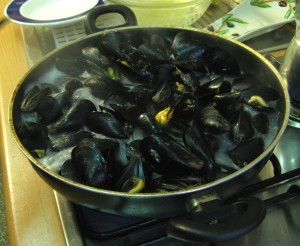
And now it’s mussels. A friend of ours went out in his boat yesterday with a fiendish contraption and scraped a huge amount of them off the pilings — wait, I’m not finished! — the pilings in the lagoon near the island of the Certosa, near the inlet of San Nicolo’, where the tide is so strong that the water is always really clean. Last night we permitted ourselves a modest gorge, annihilating a large bowl in a very short time. They were divine.
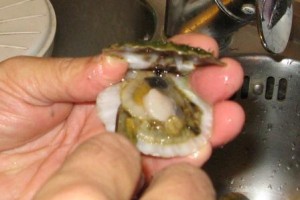
Whatever remains of the clams or the mussels is either thrown into tomato sauce for pasta later, or set aside (clams especially) for a risotto. Then we go out and get more.
I haven’t even gotten to the subject of fruit or ice cream, which are whole galaxies of delectable on their own, but I’m worn out. So let’s all put our heads down on our desks and be quiet for a few minutes.
But as we do, let me just repeat something I say far too often: It’s not easy to eat really well (not impossible, but not easy, to eat really well) in a restaurant in Venice, but here at home we eat better than the entire dynasty of Gediminids.

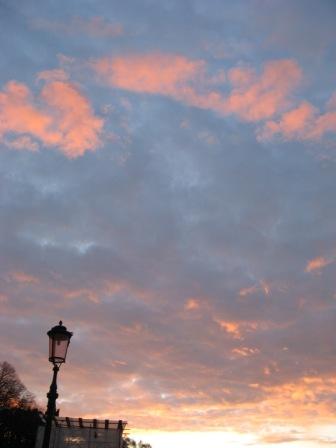 Silence. There is plenty of noise all day long here, normal third-millennium racket ranging from pneumatic drills to 40-hp motors to deafening boom-boxes in passing boats blasting that car-crash-torture-dungeon music. And on summer nights, when people tend to stay out till dawn, along about 2:00 or 3:00 there is the boisterous chorus of their inane “Good-night-it-was-great-see-you-tomorrow-I’ll-call-you-okay-I’ll-text-you” comments from right outside our bedroom window, which naturally has to be open because of the heat. You’d think somebody in the group was going off to walk across Antarctica, the way some of them carry on.
Silence. There is plenty of noise all day long here, normal third-millennium racket ranging from pneumatic drills to 40-hp motors to deafening boom-boxes in passing boats blasting that car-crash-torture-dungeon music. And on summer nights, when people tend to stay out till dawn, along about 2:00 or 3:00 there is the boisterous chorus of their inane “Good-night-it-was-great-see-you-tomorrow-I’ll-call-you-okay-I’ll-text-you” comments from right outside our bedroom window, which naturally has to be open because of the heat. You’d think somebody in the group was going off to walk across Antarctica, the way some of them carry on.